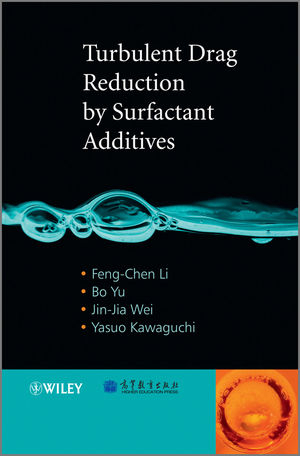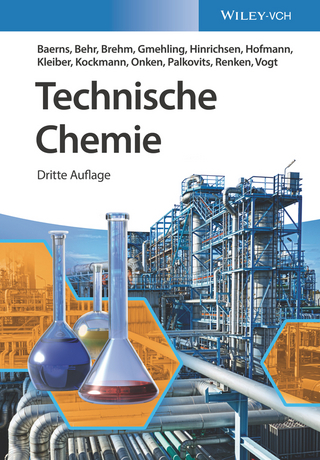
Turbulent Drag Reduction by Surfactant Additives
John Wiley & Sons Inc (Verlag)
978-1-118-18107-2 (ISBN)
Covers turbulent drag reduction, heat transfer reduction, complex rheology and the real-world applications of drag reduction
Introduces advanced testing techniques, such as PIV, LDA, and their applications in current experiments, illustrated with multiple diagrams and equations
Real-world examples of the topic’s increasingly important industrial applications enable readers to implement cost- and energy-saving measures
Explains the tools before presenting the research results, to give readers coverage of the subject from both theoretical and experimental viewpoints
Consolidates interdisciplinary information on turbulent drag reduction by additives
Turbulent Drag Reduction by Surfactant Additives is geared for researchers, graduate students, and engineers in the fields of Fluid Mechanics, Mechanical Engineering, Turbulence, Chemical Engineering, Municipal Engineering. Researchers and practitioners involved in the fields of Flow Control, Chemistry, Computational Fluid Dynamics, Experimental Fluid Dynamics, and Rheology will also find this book to be a much-needed reference on the topic.
Feng-Chen Li, Harbin Institute of Technology, China Professor Feng-Chen Li received his Ph.D. from Kyoto University in Japan, before becoming one of the members of the turbulence control community. A number of new findings have been achieved from collaborative work with colleagues and he recently initiated a pioneering work on viscoelastic-fluid-based nanofluid. Professor Li has published over 100 publications, including book chapters, journal papers and contributions at international conferences. Bo Yu, China University of Petroleum (Beijing), China ProfessorBo Yu obtained a Ph.D. degree from Xi'an Jiaotong University. He has been a full professor of the Department of Oil & Gas Storage and Transportation of China University of Petroleum at Beijing since 2005. Hiscurrent research interests include: Turbulent Flow; Computational Fluid Dynamics; Numerical Heat Transfer; Non-Newtonian Fluid Dynamics; Long-distance Transportation Technology of Waxy Crude Oil. Having published more than 50 international journal papers, he also has many awards. Jin-Jia Wei, Professor, Xi'an Jiao Tong University, China Professor Jin-Jia WEI obtained a Ph.D. degree from Xi’an Jiaotong University in China and another Ph.D degree from Kyushu University. In 2005, he became a full professor of State Key Laboratory of Multiphase Flow in Power Engineering of Xi'an Jiaotong University. His current research interests include: Turbulent Drag Reduction by Surfactant Additives and its Applications for Practical Engineering in the District Heating/Cooling System; Particle-Fluid turbulent flows in pump and pipe system; Enhanced boiling heat transfer; Thermal utilization of solar energy; Computational fluid mechanics and Brownian dynamics simulation. He has published more than150 journal and conference papers. Yasuo Kawaguchi, Tokyo University of Science, Japan Professor Yasuo Kawaguchi obtained his Ph.D. degree from Kyoto University in Japan. In April 2005, he became a full professor of Department of Mechanical Engineering, Faculty of Science and Technology, Tokyo University of Science. His current research interests include: Turbulent Drag Reduction by Surfactant Additives and its Applications for Practical Engineering in the District Heating/Cooling System; Drag reduction of water soluble polymer and is application for economization of ship propulsion; Gas-Solid particle turbulent flows relating to environmental problem, pump and pipe system; Application of laser techniques to thermal and fluid flow. He has published more than150 journal and conference papers.
Preface ix 1 Introduction 1
1.1 Background 1
1.2 Surfactant Solution 4
1.2.1 Anionic Surfactant 6
1.2.2 Cationic Surfactant 6
1.2.3 Nonionic Surfactant 7
1.2.4 Amphoteric Surfactant 7
1.2.5 Zwitterionic Surfactant 7
1.3 Mechanism and Theory of Drag Reduction by Surfactant Additives 8
1.3.1 Explanations of the Turbulent DR Mechanism from the Viewpoint of Microstructures 8
1.3.2 Explanations of the Turbulent DR Mechanism from the Viewpoint of the Physics of Turbulence 10
1.4 Application Techniques of Drag Reduction by Surfactant Additives 14
1.4.1 Heat Transfer Reduction of Surfactant Drag-reducing Flow 15
1.4.2 Diameter Effect of Surfactant Drag-reducing Flow 15
1.4.3 Toxic Effect of Cationic Surfactant Solution 15
1.4.4 Chemical Stability of Surfactant Solution 15
1.4.5 Corrosion of Surfactant Solution 16
References 16
2 Drag Reduction and Heat Transfer Reduction Characteristics of Drag-Reducing Surfactant Solution Flow 19
2.1 Fundamental Concepts of Turbulent Drag Reduction 19
2.2 Characteristics of Drag Reduction by Surfactant Additives and Its Influencing Factors 22
2.2.1 Characteristics of Drag Reduction by Surfactant Additives 23
2.2.2 Influencing Factors of Drag Reduction by Surfactant Additives 27
2.3 The Diameter Effect of Surfactant Drag-reducing Flow and Scale-up Methods 31
2.3.1 The Diameter Effect and Its Influence 31
2.3.2 Scale-up Methods 32
2.3.3 Evaluation of Different Scale-up Methods 43
2.4 Heat Transfer Characteristics of Drag-reducing Surfactant Solutionm Flow and Its Enhancement Methods 47
2.4.1 Convective Heat Transfer Characteristics of Drag-reducing Surfactant Solution Flow 47
2.4.2 Heat Transfer Enhancement Methods for Drag-reducing Surfactant Solution Flows 50
References 59
3 Turbulence Structures in Drag-Reducing Surfactant Solution Flow 63
3.1 Measurement Techniques for Turbulence Structures in Drag-Reducing Flow 64
3.1.1 Laser Doppler Velocimetry 64
3.1.2 PIV 66
3.2 Statistical Characteristics of Velocity and Temperature Fields in Drag-reducing Flow 68
3.2.1 Distribution of Averaged Quantities 69
3.2.2 Distribution of Fluctuation Intensities 74
3.2.3 Correlation Analyses of Fluctuating Quantities 77
3.2.4 Spectrum Analyses of Fluctuating Quantities 78
3.3 Characteristics of TurbulentVortex Structures in Drag-reducing Flow 83
3.3.1 Identification Method of Turbulent Vortex by Swirling Strength 84
3.3.2 Distribution Characteristics of Turbulent Vortex in the x-y Plane 85
3.3.3 Distribution Characteristics of Turbulent Vortex in the y-z Plane 87
3.3.4 Distribution Characteristics of Turbulent Vortex in the x-z Plane 90
3.4 Reynolds Shear Stress and Wall-Normal Turbulent Heat Flux 96
References 100
4 Numerical Simulation of Surfactant Drag Reduction 103
4.1 Direct Numerical Simulation of Drag-reducing Flow 104
4.1.1 A Mathematical Model of Drag-reducing Flow 104
4.1.2 The DNS Method of Drag-reducing Flow 109
4.2 RANS of Drag-reducing Flow 111
4.3 Governing Equation and DNS Method of Drag-reducing Flow 114
4.3.1 Governing Equation 114
4.3.2 Numerical Method 117
4.4 DNS Results and Discussion for Drag-reducing Flow and Heat Transfer 122
4.4.1 The Overall Study on Surfactant Drag Reduction and Heat Transfer by DNS 122
4.4.2 The Rheological Parameter Effect of DNS on Surfactant Drag Reduction 160
4.4.3 DNS with the Bilayer Model of Flows with Newtonian and Non-Newtonian Fluid Coexistence 173
4.5 Conclusion and Future Work 178
References 179
5 Microstructures and Rheological Properties of Surfactant Solution 183
5.1 Microstructures in Surfactant Solution and
Its Visualization Methods 183
5.1.1 Microstructures in Surfactant Solution 183
5.1.2 Visualization Methods for Microstructures in Surfactant Solution 187
5.2 Rheology and Measurement Methods of Surfactant Solution 189
5.2.1 Rheological Parameters 190
5.2.2 Measurement Method of Rheological Parameters 194
5.2.3 Rheological Characteristics of Dilute Drag-reducing Surfactant Solution 200
5.3 Factors Affecting the Rheological Characteristics of Surfactant
Solution 207
5.3.1 Surfactant Concentration 207
5.3.2 Temperature 208
5.3.3 Type of Surfactant 208
5.4 Characterization of Viscoelasticity of Drag-reducing Surfactant Solution by Using Free Surface Swirling Flow 209
5.5 Molecular and Brownian Dynamics Simulations of Surfactant
Solution 216
5.5.1 Brief Introduction of Simulation Methods 216
5.5.2 Brownian Dynamics Simulation by Using a WK Potential 221
References 231
6 Application Techniques for Drag Reduction by Surfactant Additives 233
6.1 Problems That Need to Be Solved in Engineering Applications 233
6.1.1 Influencing Factors of Drag-reducing Surfactant Additives on the Heat Transfer Performance of Heat Exchangers and Its Counter-measures 234
6.1.2 Influences of Drag-reducing Surfactant Additives on the Environment 235
6.1.3 Scale-up Problem 236
6.2 Separation Techniques for Surfactant Solution 237
6.2.1 Adsorption 238
6.2.2 Ultrafiltration 238
6.2.3 Reverse Osmosis 239
6.3 Drag Reduction Stability of Surfactant Solutions 239
6.3.1 Effect of Adsorption 239
6.3.2 Effects of Fe(OH)3 240
6.3.3 Effects of Cu(OH)2 241
6.3.4 Recovery of Drag Reduction 241
6.4 Applications of Surfactant Drag Reduction 242
6.4.1 Application of Surfactant to Hydronic Heating and Air-Conditioning Systems 242
6.4.2 Surfactant Selection in Actual Applications 251
References 253
Index 255
| Erscheint lt. Verlag | 28.2.2012 |
|---|---|
| Verlagsort | New York |
| Sprache | englisch |
| Maße | 178 x 254 mm |
| Gewicht | 553 g |
| Themenwelt | Naturwissenschaften ► Chemie ► Technische Chemie |
| Technik ► Maschinenbau | |
| ISBN-10 | 1-118-18107-7 / 1118181077 |
| ISBN-13 | 978-1-118-18107-2 / 9781118181072 |
| Zustand | Neuware |
| Haben Sie eine Frage zum Produkt? |
aus dem Bereich


